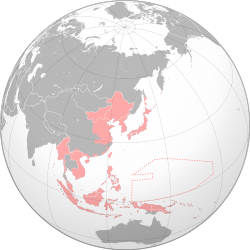
Back الاحتلال الياباني لهونغ كونغ Arabic Japanische Besetzung Hongkongs German Ocupación japonesa de Hong Kong Spanish تصرف هنگ کنگ توسط ژاپن Persian Occupation japonaise de Hong Kong French Hongkong japán megszállása Hungarian Pendudukan Jepang di Hong Kong ID Occupazione giapponese di Hong Kong Italian 日本占領時期の香港 Japanese 일본의 홍콩 점령 Korean
Hong Kong Occupied Territory | |||||||||
|---|---|---|---|---|---|---|---|---|---|
| 1941–1945 | |||||||||
Anthem:
| |||||||||
 The Hong Kong occupation zone (dark red) within the Empire of Japan (light red) at its furthest extent | |||||||||
| Status | Military occupation by the Empire of Japan | ||||||||
| Common languages | Japanese English Cantonese | ||||||||
| Religion | State Shinto Buddhism Chinese folk religion Taoism Confucianism | ||||||||
| Government | Japanese Military occupation | ||||||||
| Emperor | |||||||||
• 1941–1945 | Hirohito | ||||||||
| Governor-General | |||||||||
• 1941–1942 | Takashi Sakai Masaichi Niimi | ||||||||
• 1942–1944 | Rensuke Isogai | ||||||||
• 1944–1945 | Hisakazu Tanaka | ||||||||
| Historical era | World War II | ||||||||
| 8–25 December 1941 | |||||||||
• Surrender of Hong Kong | 25 December 1941 | ||||||||
| 15 August 1945 | |||||||||
• Handover to the Royal Navy | 30 August 1945 | ||||||||
| Area | |||||||||
| 1941[2][3] | 1,042 km2 (402 sq mi) | ||||||||
| 1945[2][4] | 1,042 km2 (402 sq mi) | ||||||||
| Population | |||||||||
| 1,639,000 | |||||||||
| 600,000 | |||||||||
| Currency | Japanese military yen | ||||||||
| |||||||||
| Today part of | People's Republic of China ∟ Hong Kong | ||||||||
| Japanese occupation of Hong Kong | |||||||||||||
|---|---|---|---|---|---|---|---|---|---|---|---|---|---|
| Traditional Chinese | 香港日治時期 | ||||||||||||
| Simplified Chinese | 香港日治时期 | ||||||||||||
| |||||||||||||
The Imperial Japanese occupation of Hong Kong began when the Governor of Hong Kong, Sir Mark Young, surrendered the British Crown colony of Hong Kong to the Empire of Japan on 25 December 1941. His surrender occurred after 18 days of fierce fighting against the Japanese forces that invaded the territory.[5][6] The occupation lasted for three years and eight months until Japan surrendered at the end of the Second World War. The length of the period (三年零八個月, lit. 'three years and eight months') later became a metonym of the occupation.[6]
- ^ Fung, Chi Ming (2005). Reluctant heroes: rickshaw pullers in Hong Kong and Canton, 1874–1954. Hong Kong University Press. ISBN 978-962-209-734-6. pp. 130, 135.
- ^ a b Courtauld, Caroline. Holdsworth, May (1997). The Hong Kong Story. Oxford University Press. ISBN 0-19-590353-6. pp. 54–58.
- ^ Stanford, David (2006). Roses in December. Lulu press. ISBN 1-84753-966-1.
- ^ Chan, Shun-hing. Leung, Beatrice (2003). Changing Church and State Relations in Hong Kong, 1950–2000. Hong Kong: HK University Press. p. 24. ISBN 962-209-612-3.
- ^ Snow, Philip (2004). The fall of Hong Kong: Britain, China and the Japanese occupation. Yale University Press. ISBN 978-0-300-10373-1.
- ^ a b Mark, Chi-Kwan. (2004). Hong Kong and the Cold War: Anglo-American relations 1949–1957. Oxford University Press. ISBN 978-0-19-927370-6. p. 14.

